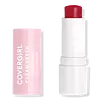Covergirl Clean Fresh Tinted Lip Balm Versus Haus Labs By Lady Gaga Atomic Shake Long Lasting Liquid Lipstick
What's inside
What's inside
 Key Ingredients
Key Ingredients

 Benefits
Benefits

 Concerns
Concerns

 Ingredients Side-by-side
Ingredients Side-by-side

Polybutene
Hydrogenated Polyisobutene
EmollientOctyldodecanol
EmollientPolyethylene
AbrasiveCaprylic/Capric Triglyceride
MaskingHydrogenated Poly(C6-14 Olefin)
EmollientDicalcium Phosphate
AbrasiveCera Microcristallina
Emulsion StabilisingSynthetic Wax
AbrasiveStearalkonium Bentonite
Gel FormingPentaerythrityl Tetra-Di-T-Butyl Hydroxyhydrocinnamate
AntioxidantPropylene Carbonate
SolventPunica Granatum Extract
AstringentRicinus Communis Seed Oil
MaskingSodium Hyaluronate
HumectantMica
Cosmetic ColorantHydrogenated Castor Oil
EmollientSynthetic Fluorphlogopite
Silica
AbrasiveTin Oxide
AbrasiveIron Oxides
CI 77891
Cosmetic ColorantCI 15850
Cosmetic ColorantCI 19140
Cosmetic ColorantCI 45410
Cosmetic ColorantCI 42090
Cosmetic ColorantPolybutene, Hydrogenated Polyisobutene, Octyldodecanol, Polyethylene, Caprylic/Capric Triglyceride, Hydrogenated Poly(C6-14 Olefin), Dicalcium Phosphate, Cera Microcristallina, Synthetic Wax, Stearalkonium Bentonite, Pentaerythrityl Tetra-Di-T-Butyl Hydroxyhydrocinnamate, Propylene Carbonate, Punica Granatum Extract, Ricinus Communis Seed Oil, Sodium Hyaluronate, Mica, Hydrogenated Castor Oil, Synthetic Fluorphlogopite, Silica, Tin Oxide, Iron Oxides, CI 77891, CI 15850, CI 19140, CI 45410, CI 42090
Isododecane
EmollientDiphenyl Dimethicone
EmollientTrioctyldodecyl Citrate
EmollientPolyurethane-1
Disiloxane
Skin ConditioningDi-C12-13 Alkyl Tartrate
EmollientBis-Hydroxyethoxypropyl Dimethicone/Ipdi Copolymer Ethylcarbamate
Alcohol
AntimicrobialDipentaerythrityl Pentaisononanoate
EmollientSodium Hyaluronate
HumectantUndaria Pinnatifida Extract
Skin ConditioningEthylhexyl Palmitate
EmollientCaprylic/Capric Triglyceride
MaskingGlucomannan
Skin ConditioningTrihydroxystearin
Skin ConditioningDicalcium Phosphate
AbrasiveCI 77891
Cosmetic ColorantCI 77491
Cosmetic ColorantCI 15850
Cosmetic ColorantCI 45410
Cosmetic ColorantCI 42090
Cosmetic ColorantCI 19140
Cosmetic ColorantCI 15985
Cosmetic ColorantIsododecane, Diphenyl Dimethicone, Trioctyldodecyl Citrate, Polyurethane-1, Disiloxane, Di-C12-13 Alkyl Tartrate, Bis-Hydroxyethoxypropyl Dimethicone/Ipdi Copolymer Ethylcarbamate, Alcohol, Dipentaerythrityl Pentaisononanoate, Sodium Hyaluronate, Undaria Pinnatifida Extract, Ethylhexyl Palmitate, Caprylic/Capric Triglyceride, Glucomannan, Trihydroxystearin, Dicalcium Phosphate, CI 77891, CI 77491, CI 15850, CI 45410, CI 42090, CI 19140, CI 15985
Ingredients Explained
These ingredients are found in both products.
Ingredients higher up in an ingredient list are typically present in a larger amount.
This ingredient is an emollient, solvent, and texture enhancer. It is considered a skin-softener by helping the skin prevent moisture loss.
It helps thicken a product's formula and makes it easier to spread by dissolving clumping compounds.
Caprylic Triglyceride is made by combining glycerin with coconut oil, forming a clear liquid.
While there is an assumption Caprylic Triglyceride can clog pores due to it being derived from coconut oil, there is no research supporting this.
Learn more about Caprylic/Capric TriglycerideCi 15850 is the pigment color red. It is an azo dye and created synthetically.
Azo dyes need to be thoroughly purified before use. This allows them to be more stable and longer-lasting.
This ingredient is common in foundations, lipsticks, and blushes. This color is described as brown/orangey red.
It has many secondary names such as Red 6 and Red 7. According to a manufacturer, Red 6 usually contains aluminum.
Learn more about CI 15850CI 19140 is also known as Tartrazine. Tartrazine is a synthetic dye used in cosmetics, foods, and medicine to add a yellow color.
Tartrazine is created from petroleum and is water-soluble.
Some people may experience allergies from this dye, especially asthmatics and those with an aspirin intolerance.
Learn more about CI 19140Ci 42090 is a synthetic dye created from petroleum. It is used to give a bright blue color to cosmetics, medicine, and food.
CI 45410 is a synthetic red-pigment and dye.
It often goes by both Red 28 or Red 27; manufacturers label both ingredients as CI 45410.
This dye is commonly found in makeup because it imparts a vivid color. Some types of this dye change color based on pH level and interaction with moisture:
Your skin has a natural pH of around 4.5 - 5.5.
According to the FDA, CI 45410 is not permitted for use in eye products.
Red 27 is a flourescein dye and commonly used as a fluorescent tracer in medicine.
Learn more about CI 45410Ci 77891 is a white pigment from Titanium dioxide. It is naturally found in minerals such as rutile and ilmenite.
It's main function is to add a white color to cosmetics. It can also be mixed with other colors to create different shades.
Ci 77891 is commonly found in sunscreens due to its ability to block UV rays.
Learn more about CI 77891Dicalcium Phosphate is an exfoliant.
Sodium Hyaluronate is hyaluronic acid's salt form. It is commonly derived from the sodium salt of hyaluronic acid.
Like hyaluronic acid, it is great at holding water and acts as a humectant. This makes it a great skin hydrating ingredient.
Sodium Hyaluronate is naturally occurring in our bodies and is mostly found in eye fluid and joints.
These are some other common types of Hyaluronic Acid:
Learn more about Sodium Hyaluronate